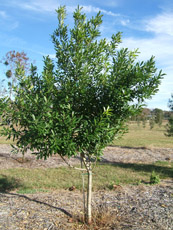Ilex cassine (Dahoon Holly)

*Click on picture for more images of this species.
- USDA Hardiness Zone: 7A - 11
- Mature Height: 20 to 30 ft
- Mature Spread: 8 to 12 ft
- Growth Rate: Moderate
- Availability: Generally available
- Drought Tolerance: Moderate
- Salt Tolerance: Moderate
- Light Requirements: Full sun to partial sun
- Native Origin: Native to Florida
- Soil Drainage: Tolerates well-drained sites to sites with extended flooding.
- Foliage: Evergreen tree with no showy fall color.
- Flowers: White, not showy flowers in the spring.
- Pests: Free of serious pests and diseases, mites can be a problem in dry sites.
Description: Attractive when tightly clipped into a tall screen or allowed to grow naturally into its single-trunked, small tree form, Dahoon Holly is ideal for a variety of landscape settings. Capable of reaching 40 feet in height and width, Dahoon Holly is usually seen at a height of 20 to 30 feet with a 12 to 20-foot spread. The smooth, supple, shiny dark green, evergreen leaves, two to three inches long, have just a few serrations near the tip. Possessing male and female flowers on separate plants, at least two Dahoon Hollies (male and female) must be planted in the landscape to ensure production of the brilliant red berries in fall and winter. The berries serve as an excellent food source for wildlife but are far less prevalent than on East Palatka or Fosters Holly.
Growing well in full sun to partial shade, Dahoon Holly does best on moist soils since the wet, boggy soils of swamps is its native environment. Dahoon Holly can tolerate drier locations with some watering, but often has a thin crown in this environment. It is not recommended in the southern part of its range in a dry, exposed site unless irrigation is occasionally provided. It lends itself well to use as a specimen or street tree, and is ideal for naturalizing in moist locations. Little pruning is needed to create a well-structured, strong tree. It appears to adapt well to the confined spaces of urban and downtown landscapes and is tolerant of some salt spray. The crown is fuller in full sun.
Gainesville Observations: This tree has reached the main-stream of horticulture by now and is used throughout the state for a variety of purposes. Trees appear to be fairly easy to train into a dominant leader which is suited for planting along streets. All trees in our test are trained to one trunk. It is fairly simple to reduce the upright stems back to lateral branches oriented more horizontally because there are many branches to work with. Trees can be trained with branches to the ground or the lower trunk can be cleared of branches for a "standard". Most growers shear the tree (and most other tree-form hollies) into a cone, but this is not necessary. Prune to one leader in the center of the canopy.
Fact Sheet (pdf)
Click here for more photos of this tree.

